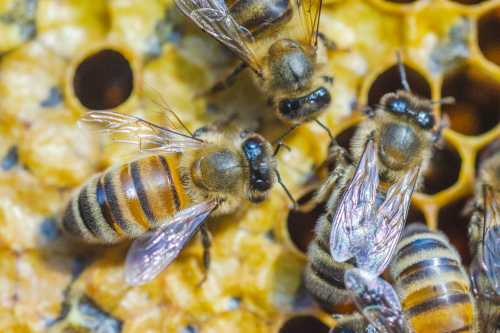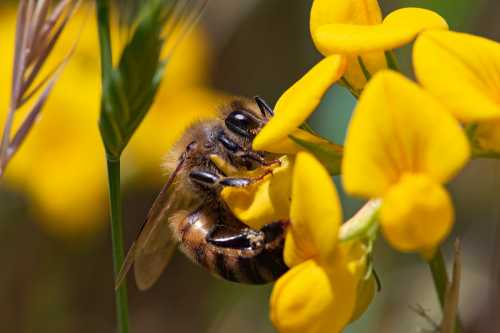Do Bees have An Immune System?
All organisms need some kind of immune system to protect them from other organisms that might cause disease or death.
The immune system is a system rather than one specific organ or tissue because it is a network of processes that (in mammals) involves a number of organs, tissues and chemical activity in the body.
The basic process can be broken down into 4 interlinked and continuous parts:
- Detection of invasion threat (eg by viruses or fungi)
- Creation of ‘anti-invasion’ mechanisms (prevention)
- Elimination of invasive threat
- Maintenance
of specific immunity (immunological memory).
Do Bees Have A Need For An Immune System?

All organisms can be susceptible to attack or invasion by infective organisms, and bees are no exception.
Indeed, it has long been pointed out (Wilson, 1971) that because honey bee colonies consist of a large number of individuals living in close quarters at very high densities, and with a relatively stable and unchanging nest environment (Schmid-Hempel, 1998), then they may be more susceptible to infection than other species.
There are a number of pathogenic organisms that can infect bees, causing disease and death.
Examples include:
- deformed wing virus (DWV);
- Varroa destructor (a mite);
- Paenibacillus larvae (a bacterial pathogen of honey bee brood);
- Serratia
marcescens (a bacterium that is often seen as a pinkish-red ‘mold’ in human
communal washrooms, which can cause septicemia in honey bee larvae and
adults).
Disease Resistance And Immunity In Bees
Recognition of a pathogen or threat starts a response process that leads to the creation of ‘anti-invasion’ processes, that lead to the elimination of the invasive threat.

Behaviors
In honey bees, many responses to diseases and pathogen threat are carried out by multiple bees, effectively resulting in a 'social' response to combatting threats.
Examples of these include:
Grooming
Grooming is a method by which bees keep themselves clean.
Grooming away of mites (which can spread diseases and impair colony health) and foreign particles found on the body (and the killing of mites found on individual bees), and picked up from the environment, for example, during foraging trips.
An individual bee may groom herself (auto-grooming) or one bee may groom another bee (allo-grooming).
Hygienic Behavior
Hygienic behavior is a collective response by adult bees in the removal of diseased and parasitized worker brood (larvae and pupae).
Undertaking
This involves the removal of dead carcasses (bees and dead insect intruders) and debris from the nest or hive by adult workers. This prevents a build up of decomposing, unhygienic matter in the nest or hive.
Temperature control
Honey bees are known to form heat balls around predators like wasps and hornets, as well as foreign queens, thus killing the intruder.
Some studies suggest that bees may generate a fever response when faced with a pathogen challenge.

Self-medication
Some of the barriers to disease occur as a result of 'medicated' products brought into, and developed within the hive:
Propolis
The resin content of propolis provides a natural, antimicrobial defensive barrier used by bees to seal gaps in the nest or hive, but also to 'mummify' debris or foreign objects the bees are unable to remove, to prevent decay causing infections.
 The antimicrobial properties of propolis help to maintain hygiene in the hive or nest
The antimicrobial properties of propolis help to maintain hygiene in the hive or nestDiet
Diet can significantly contribute to colony health.
For example, research suggests that honey bees forage and store (in the form of honey) highly antibiotic plant products, especially from herbs such as thyme plants, that can inhibit pathogen growth.
(As an aside, it has also been found that certain compounds within floral nectar (e.g. anabasine, nicotine and thymol) can also reduce parasite loads in bumble bees). For further information see - Herb Planting For Bees.
 Some plants, such as Thyme, may offer antibiotic benefits to bees
Some plants, such as Thyme, may offer antibiotic benefits to bees
Individual Immunity In Bees
The immune system of individual honey bees plays a key role in colony health status together with colony-level anti-pathogen 'hygienic behaviours'.
The main mechanisms within the individual bee immune system are:
- creation of internal proteins that are anti-microbial;
- phagocytosis (that is, creation of bee cells that ‘eat’ the pathogen cells); and
- destruction of pathogens by specific enzymes.

What issues are negatively affecting bee immunity?
A number of environmental factors may lead to a reduction in the ability of bees to combat infection.
Introduction of a new parasite or pathogen
The transport of diseases and mites from bees in one region of the world to another, can cause devastation to newly infected bee populations.
For example, Varroa destructor mite was originally a pest of the Asian honey bee, Apis cerana, which had evolved effective mechanisms to survive the mite.
However, the introduction of Varroa mite into Europe caused problems for the Western honey bee, Apis mellifera for whom the mite was a new pest.
Programs are now in development to breed Apis mellifera that have developed the required hygienic behaviours to recognise and deal with this particular mite. See - Varroa Resistant Honey Bees.
Agrochemical exposure
Agrochemicals can severely hamper the immune system in bees.
For example, neonicotinoid exposure has been reported to act synergistically with pathogens, by reducing immune defences and promoting the replication of the deformed wing virus in honey bees.
It is questionable as to whether neonicotinoids hamper behaviours such as personal grooming, since this is reported as a major mode of action for the sellers of a neonicotinoid in the treatment of termites - see How Do Neonicotinoids Work?
Resources
- Wilson E. (1971) ‘The Insect Societies’, Cambridge, MA: Harvard University Press; 1971
- Schmid-Hempel, P. (1998) ‘Parasites in Social Insects’, Princeton, NJ: Princeton University Press; 1998.
- Evans JD, Spivak M. Socialized medicine: individual and communal disease barriers in honey bees. J Invertebr Pathol. 2010 Jan;103 Suppl 1:S62-72. doi: 10.1016/j.jip.2009.06.019. Epub 2009 Nov 11. PMID: 19909975.
- Barosso-Arevalo, S. et al (2019) ‘Immune related
genes as markers for monitoring health status of honey bee colonies’, BMC
Veterinary Research, 15, 72. https://doi.org/10.1186/s12917-019-1823-y

